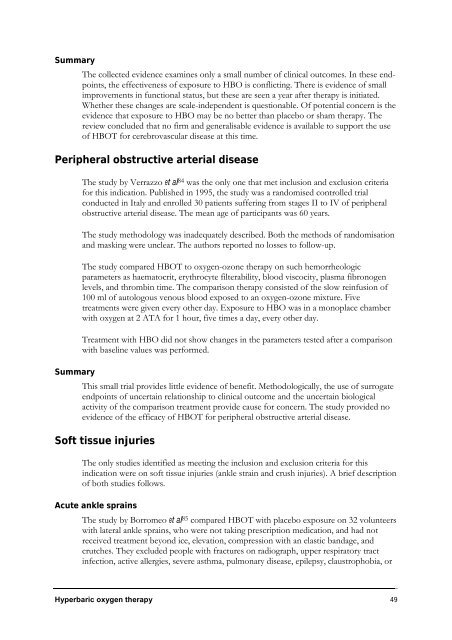Hyperbaric Oxygen Therapy - Hyperbaric Chamber Information ...
Hyperbaric Oxygen Therapy - Hyperbaric Chamber Information ...
Hyperbaric Oxygen Therapy - Hyperbaric Chamber Information ...
You also want an ePaper? Increase the reach of your titles
YUMPU automatically turns print PDFs into web optimized ePapers that Google loves.
Summary<br />
The collected evidence examines only a small number of clinical outcomes. In these endpoints,<br />
the effectiveness of exposure to HBO is conflicting. There is evidence of small<br />
improvements in functional status, but these are seen a year after therapy is initiated.<br />
Whether these changes are scale-independent is questionable. Of potential concern is the<br />
evidence that exposure to HBO may be no better than placebo or sham therapy. The<br />
review concluded that no firm and generalisable evidence is available to support the use<br />
of HBOT for cerebrovascular disease at this time.<br />
Peripheral obstructive arterial disease<br />
The study by Verrazzo et al 84 was the only one that met inclusion and exclusion criteria<br />
for this indication. Published in 1995, the study was a randomised controlled trial<br />
conducted in Italy and enrolled 30 patients suffering from stages II to IV of peripheral<br />
obstructive arterial disease. The mean age of participants was 60 years.<br />
The study methodology was inadequately described. Both the methods of randomisation<br />
and masking were unclear. The authors reported no losses to follow-up.<br />
The study compared HBOT to oxygen-ozone therapy on such hemorrheologic<br />
parameters as haematocrit, erythrocyte filterability, blood viscocity, plasma fibronogen<br />
levels, and thrombin time. The comparison therapy consisted of the slow reinfusion of<br />
100 ml of autologous venous blood exposed to an oxygen-ozone mixture. Five<br />
treatments were given every other day. Exposure to HBO was in a monoplace chamber<br />
with oxygen at 2 ATA for 1 hour, five times a day, every other day.<br />
Treatment with HBO did not show changes in the parameters tested after a comparison<br />
with baseline values was performed.<br />
Summary<br />
This small trial provides little evidence of benefit. Methodologically, the use of surrogate<br />
endpoints of uncertain relationship to clinical outcome and the uncertain biological<br />
activity of the comparison treatment provide cause for concern. The study provided no<br />
evidence of the efficacy of HBOT for peripheral obstructive arterial disease.<br />
Soft tissue injuries<br />
The only studies identified as meeting the inclusion and exclusion criteria for this<br />
indication were on soft tissue injuries (ankle strain and crush injuries). A brief description<br />
of both studies follows.<br />
Acute ankle sprains<br />
The study by Borromeo et al85 compared HBOT with placebo exposure on 32 volunteers<br />
with lateral ankle sprains, who were not taking prescription medication, and had not<br />
received treatment beyond ice, elevation, compression with an elastic bandage, and<br />
crutches. They excluded people with fractures on radiograph, upper respiratory tract<br />
infection, active allergies, severe asthma, pulmonary disease, epilepsy, claustrophobia, or<br />
<strong>Hyperbaric</strong> oxygen therapy 49



